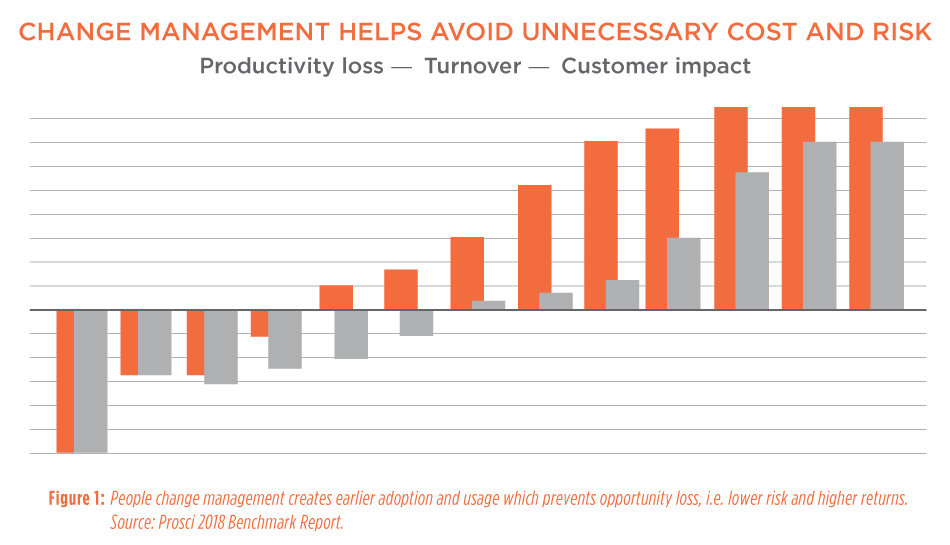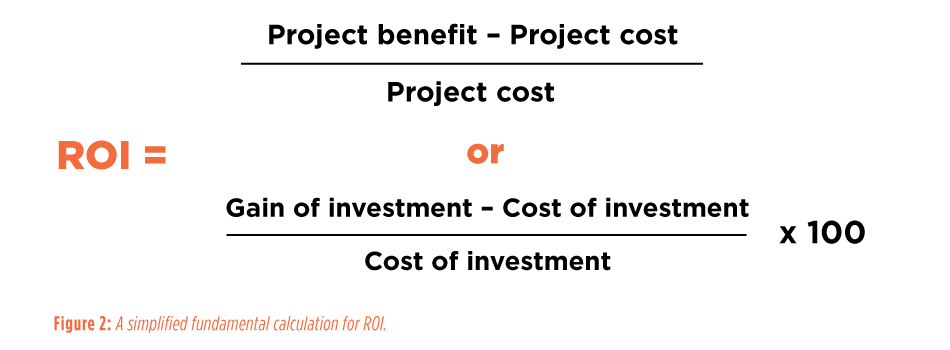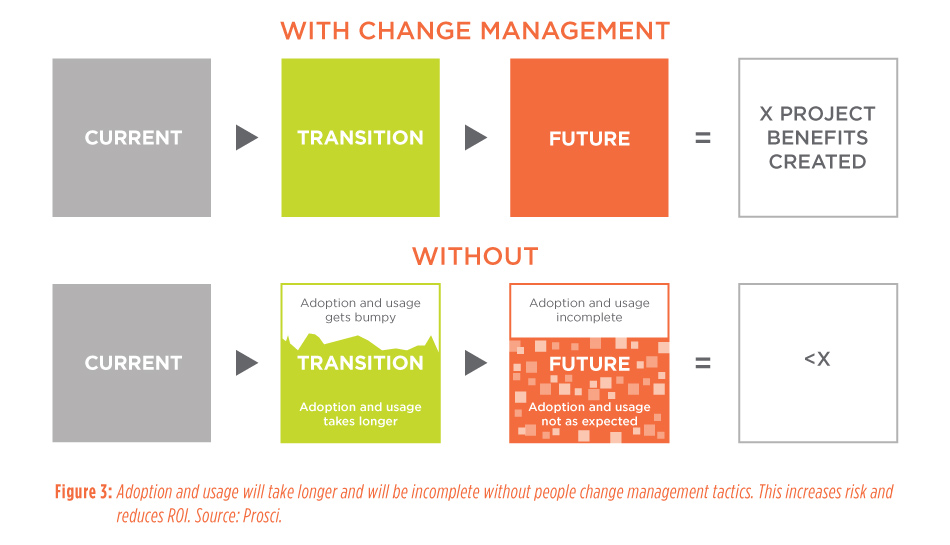
In January 2020, Larry Fink, CEO of the investment management company BlackRock, addressed a letter — entitled “A Fundamental Reshaping of Finance” — to fellow CEOs, investors and stakeholders worldwide. In the letter, Fink emphasized that investors should work to avoid risks, focusing specifically on the impacts rising climate risks can have on many portfolios. In the near future, he explained, “there will be a significant reallocation of capital” in light of changing attitudes toward climate change.
As such, Fink announced in the letter that BlackRock would begin investing in sustainability approaches and withdrawing its support of fossil fuel extractions — all with the goal of moving toward a low-carbon economy. The ramifications of this paradigm in investment will be felt for years across various industries.
Paradigms like this and new processes are being implemented every day. Helping people adopt and utilize these altered mindsets and process is important to obtaining resources for capital-funded projects in the utility world. People change management specializes in doing this. Understanding how utilities are structured, how a utility handles risk considerations, and how and why it’s necessary to procure capital funding allows people change managers to properly word and position business cases to help obtain the necessary resources and bring about full project success.
Read The White Paper

In January 2020, Larry Fink, CEO of the investment management company BlackRock, addressed a letter — entitled “A Fundamental Reshaping of Finance” — to fellow CEOs, investors and stakeholders worldwide. In the letter, Fink emphasized that investors should work to avoid risks, focusing specifically on the impacts rising climate risks can have on many portfolios. In the near future, he explained, “there will be a significant reallocation of capital” in light of changing attitudes toward climate change.
As such, Fink announced in the letter that BlackRock would begin investing in sustainability approaches and withdrawing its support of fossil fuel extractions — all with the goal of moving toward a low-carbon economy. The ramifications of this paradigm in investment will be felt for years across various industries.
Paradigms like this and new processes are being implemented every day. Helping people adopt and utilize these altered mindsets and process is important to obtaining resources for capital-funded projects in the utility world. People change management specializes in doing this. Understanding how utilities are structured, how a utility handles risk considerations, and how and why it’s necessary to procure capital funding allows people change managers to properly word and position business cases to help obtain the necessary resources and bring about full project success.
Building a Business Plan for People Change Management
Business plans are created to seek funding by demonstrating the prospect of profit. The good news is that all financial decisions, including capital project funding, are made by actual people — people who rely on the data they have on hand to make effective rulings and provide a sense of direction. Building awareness and desire within these people for people change management for capital-funded projects is a dual proposition requiring application in both directions: change management with those who propose and approve business plans, and change management with those who are responsible for the actual project execution and need the resources to bring about project success.
The Players and the Game
Understanding how utilities are structured and how a utility procures funding for projects is imperative for utility people change managers to correctly position their business cases and create pull from those who fund them. The two main players in the utilities sector are capital investors and capital project stakeholders.
What Does ‘Utilities Sector’ Mean?
The utilities sector refers to a category of companies that provide basic amenities, such as water, sewage, electricity and natural gas services. Although utilities earn profits, they are part of the public service landscape and are, therefore, heavily regulated. Investors typically treat utilities as long-term holdings and use them to inject steady income into their portfolios.
Utility Sector Breakdown
While electric utility companies used to be regionally monopolistic, broadly speaking, the industry is settling into the following four supplier segments:
- Generators: Operators whose business is to create electrical power.
- Energy network operators: Grid operators, regional network operators and distribution network operators who sell access to their networks to retail service providers.
- Energy traders and marketers: By buying and selling energy futures and other derivatives to create complex, structured products, these companies usefully help utilities and power-hungry businesses secure a dependable supply of electricity at a stable, predictable price.
- Energy service providers and retailers: In most U.S. states, consumers can now choose their own retail service providers.
There are currently dozens of power marketers. These are wholesale power companies that have registered with the Federal Energy Regulatory Commission in order to buy power at wholesale prices and sell the power to other marketers or public entities at market prices.
Why Utility Regulatory Bodies Should Care About People Change Management
In the U.S., the governing body that regulates the rates and services of a public utility is a utilities commission, such as a utility regulatory commission, a public utilities commission or a public service commission. The National Association of Regulatory Utility Commissioners represents the state public service commissioners who regulate essential utility services, including energy, telecommunications and water.
These are invested stakeholders. There are other variations of these organizations, such as civil service oversight bodies (public service commissions), but share their top concern: assuring reliable utility service at fair, just and reasonable rates. Inserting people change management practices into capital-funded projects is an effective way to secure these conditions through successful project, process and technology adoption.
Understanding Capital Funding
Capital is a term for financial assets, such as funds held in deposit accounts or obtained from special financing sources. Capital can also be associated with capital assets of a company that requires significant amounts of capital to finance or expand.
Capital funding is the money that lenders and equity holders provide to a business for daily and long-term needs. A company’s capital funding consists of both debt (in bonds) and equity (in stock). The business then utilizes this money for operating capital while the bond and equity holders expect to see a return on investment (ROI) in the form of interest, dividends and stock appreciation.
To acquire capital or fixed assets — such as land, buildings and machinery — businesses usually raise funds through capital funding programs. There are two primary routes a business can take to access funding: raising capital through stock issuance and raising capital through debt.
If the asset is strictly a fixed asset, then no people change management would be required. But if the business plan assumes people must interact with the assets at varying levels, then the tasks and milestones of change management must be integrated into the business and project plans to realize full ROI. Keep in mind that delays in adoption and usage of new processes and technologies cost investors and stakeholders money in the form of opportunity loss, or the difference between the optimal payoff and the actual payoff.
Utilities Sector Revenue Sources
Utilities are stable investments that provide a regular dividend to shareholders, making them a popular long-term, buy-and-hold option. Dividend yields are usually higher than those paid by other stocks. During times of economic downturns or with low market interest rates, utilities provide a stable, safe-haven investment. Investors may invest in utility company shares, industry sector exchange-traded funds, and in utility bonds or other debt securities.
Due to the utility sector’s intense regulatory oversight, it’s difficult for it to raise rates to increase revenue. This is where people change management can assist to reduce initial investment costs and maximize asset utilization. Utilities require expensive infrastructure that needs routine updating and maintenance. To meet these infrastructure needs, utility companies often float debt products that, in turn, increase their debt loads. This debt also makes these services particularly sensitive to interest rate risk. Should rates rise, the company usually offers higher yields to attract bond investors, further driving up costs. Higher yields must be generated through change. People change managers can help identify, define and manage that change on either end of the funding process — generating funds or reducing waste.
The Utilities Sector as Seen Through the Eyes of a Utility Investor
Investor-owned utilities must make long-term capital investments to build and maintain grid infrastructure. As in any industry, capital investments are financed through a combination of debt and equity. Because utility stocks often pay reliable dividends, investors often favor them over lower dividend-paying equities. Therefore, investors flocked to utilities after the financial crisis of 2008, seeing utilities as safer investments when the Federal Reserve cut interest rates
Utility companies are viewed as a viable defensive play for investors during macroeconomic downturns. But those investments can weaken with delayed or low adoption and usage of new solutions, processes and technologies that are designed to increase efficiency and decrease waste. These potential delays provide a strong argument for including people change managers within capital-funded projects.
Ultimately, every utility has a responsibility for rate recovery from a capital spend standpoint and must be able to justify the spend as part of the rate case. Latching onto tactics that reduce waste and speed up adoption makes economic sense. People change management must become an essential part of the business case, informing the capital spend by bringing higher success rates to the implementation of projects.
Why Capital Investors Should Care About People Change Management
Capital investors work to avoid risk. This is a distinct and important motivation to understand. To encourage investors to invest in risky projects, the returns from such projects should be higher than the returns from less risky investments. Because many capital projects fail due to people not adopting and utilizing the new solutions or strategy, this leaves a considerable percentage of a project’s ROI at risk — something capital investors want to avoid.
To reduce that risk and capture the full investment value, projects must consider incorporating people change management as an inseparable piece of the project planning and delivery process. This can be easier said than done if a utility or company has not positioned people change management in the eyes of a funding grantor.
One way to get ahead of this is to demonstrate the value of change management by calculating the ROI for people change management. The fundamental calculation for ROI is simplified in Figure 2.
A portion of a capital project’s ROI will be seen by the business once the technical asset is in place. However, if the project requires people to do and think differently, then there is an additional portion of ROI that is not always quantified or qualified, requiring adoption and usage.
At its roots, these calculations show that “saving” money through the exclusion of people change management is a false saving. The lack of people change management almost always means higher, tangible risk that — in the end — will cost the organization actual return on its capital project investment.
Why Utility Shareholders Should Care About People Change Management
Businesses finance their long-term capital investments through a combination of corporate debt (taking loans or issuing bonds) and equity (selling ownership stakes or issuing shares). Debt carries an obligation of payment to creditors, while equity provides a profit opportunity for shareholders.
Revenues from a business’s operation must go to pay creditors first; shareholders retain whatever remains after accounting for all costs — including the cost of operations, taxes and other expenses. Since shareholders face more risk than creditors, shareholders generally expect a return on their capital (or return on equity) that is higher than the returns or interest that creditors expect on their capital. A business’s cost of capital is thus a mixture of returns to creditors and returns to equity providers.
For all businesses, the cost of debt is largely influenced by their credit ratings, which are determined by independent financial agencies. These ratings are analogous to an individual’s FICO score. The cost of equity, on the other hand, is determined by market forces in competitive industries — that is, by the interactions between those with varying levels of risk appetite who seek profit opportunities and those who provide opportunities for investment at varying levels of risk.
Most projects require people do their jobs differently than normal or, at the very least, develop a change in mindset. The discipline of change management — with a focus on people — integrates with project management to realize the full people-dependent ROI of projects.
How Debt Levels of the Utilities Sector Could Increase Unnecessarily
Because utilities require a significant amount of expensive infrastructure to operate, they carry large amounts of debt on their balance sheets. These debt loads make utilities hypersensitive to changes in market interest rates. Utilities are capital-intensive, requiring a continuous inflow of funds to finance infrastructure upgrades and new asset purchases. Significant debt load results in a high debt-to-equity (D/E) ratio, which can impact credit ratings and make it difficult to borrow funds, ultimately increasing a utility’s cost of operations. People change management integrated with project management on capital projects can lower that risk and reduce the D/E ratio by reducing initial installation costs and future operational costs of said infrastructure.
Delays in people adopting and using any solution create additional cost and increases operational costs. For example, if $20 million was invested with proposed return of $40 million over a certain time frame and only 30% of people adopt, use and perform well within the new operating structure due to little or no people change management integrated during rollout, then further investments would be required or the project may be scrapped, incurring additional costs.
Consumer Behavior Impacts the Utilities Sector
Because many states let consumers move from one utility operator to another, consumers typically choose the least expensive local operator. Higher-cost producers are eventually eliminated from the market, unless they can cut their costs in time. Both lower- and higher-cost producers can benefit greatly from systems designed and implemented in such a way as to reduce bumps and shore up efforts to create positive and profitable change.
Long-term power purchase agreements between companies and consumers also impact profits. When utility generation costs increase, companies must continue to honor their contract agreements and sell power at the current agreed upon rate, which decreases their profits. And a decrease in operating costs benefits all.
Conclusion
The utility sector’s regulatory oversight, debt and rate structures, and investment vehicles offer unique challenges and opportunities for the people change manager whose job it is to see that technical solutions and assets are adopted and used and not just designed and built.
By understanding how utilities are structured and how and why they procure capital funding, people change managers within the utility industry can create and utilize tactics, correct verbiage and context to build strong business cases for people change management on capital funded projects. In this way, utilities can inform capital spending by providing a business case for higher success rates in the implementation of various projects.









